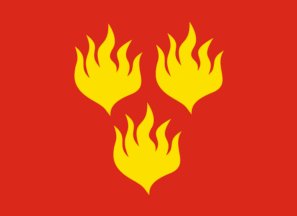 christopher oehler
christopher oehler
Keywords: karasjok | karasjoga | flame | fire |
Links: FOTW homepage | search | disclaimer and copyright | write us | mirrors

Last modified: 2021-08-25 by  christopher oehler
christopher oehler
Keywords: karasjok | karasjoga | flame | fire |
Links: FOTW homepage |
search |
disclaimer and copyright |
write us |
mirrors
 image by Tomislav Šipek, 13 February 2017
image by Tomislav Šipek, 13 February 2017
Approved on 27 June 1986.
See also:
On 27 June 1986 a Royal resolution approved arms and flag for Karasjok/Kárásjoga
municipality in Finnmark county. The flag is defined as "In red three
yellow flames with five tongues, two over one." According to Norske kommunevåpen [c2j87] flames were chosen as charge because fire
is an important condition for sustaining life, especially on a mountain plateau
like the one Karasjok/Kárásjoga is situated in and where a significant part of
the population long had a nomadic way of life, partly still sustained by Saami
reindeer herders. The fire is also the point around which people gather and it
is a guard against dangers. According to Norske kommunevåpen
the flag contains three flames, not only to fill out the field as is required by
the norms of heraldry, but also to suggest that Karasjok/Kárásjoga is a place
where three peoples live: the Saami, Norwegians and Finns. This is also partly
reflected in the name of the municipality: The name is Karasjok in Norwegian and
Kárásjoga in Saami, both versions are official.
Jan Oskar Engene, 27 April 2002
Flagg og våpen. Flagg fra alle verdens stater. Våpen fra alle norske kommuner og
fylker [sga95] gives Kárášjohka/Karasjok. Could
Karasjohka be the Finnish name of the municipality, or is it a former Saami name
now superseded by Karasjoga? (Or is it a mistake in Flagg og våpen.?)
Ivan Sache, 27 April 2002
I do not believe Karasjohka is the Finnish form of the name. It is a Saami
name. Though I am not sure, I believe there may have been a change in spelling
at some point and that the spelling is now Kárásjoga.
Jan Oskar Engene, 28 April 2002
The three flames symbolize the union of the three peoples; Saami, Norwegians and "Kvæns". "Kvæns" are originally from Finland, but have adapted into Saami ways of life. They are therefore technically neither Finns or Saami.
As for the correct spelling and questions about Finnish spelling being discussed, I have the following information to clear up confusion:
So basically, Kárájoga Gielda means "Karasjok's Commune", whilst
the village is named Karasjok. Saami grammar makes it turn in to "Kárásjoga",
while English grammar would only add the apostrophe and an s, as in Karasjok's.
Jens Petter Kåven, 20 January 2004
![[COA of Karasjok]](../images/n/no)20-21.gif) image by Tomislav Šipek, 31 December 2015
image by Tomislav Šipek, 31 December 2015
Here is coat of arms and a better image of flag.
Tomislav Šipek, 31 December 2015
Official blazon in Norwegian: "I rødt tre femtungede gule flamer,
2-1."
Blazoned in English: "Gules three five-tongued flames or two and
one."
English blazon by Joe McMillan, 30 July 2002